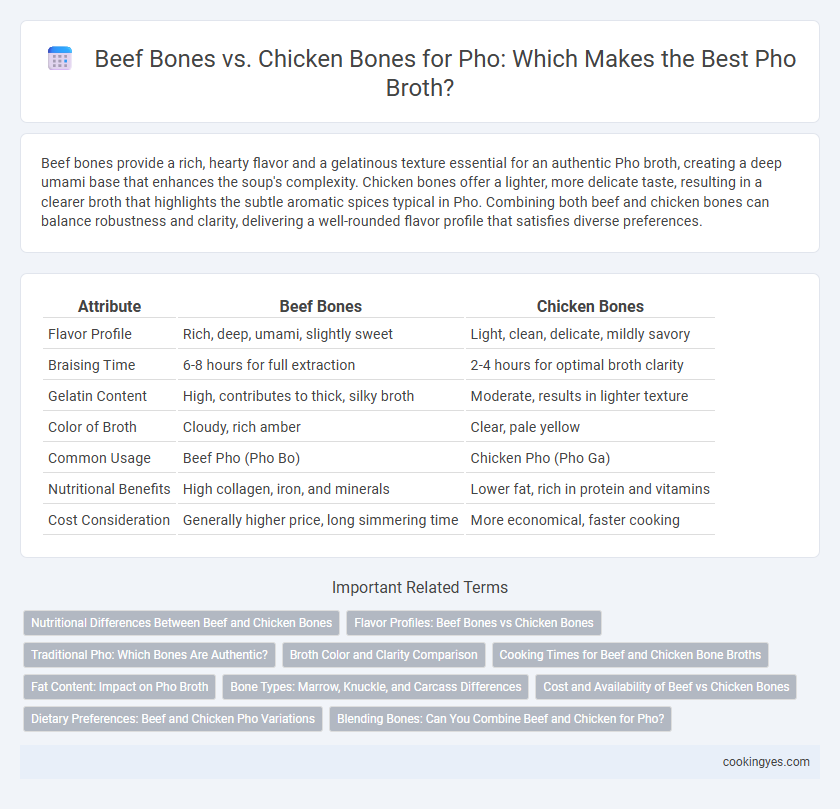Beef bones provide a rich, hearty flavor and a gelatinous texture essential for an authentic Pho broth, creating a deep umami base that enhances the soup's complexity. Chicken bones offer a lighter, more delicate taste, resulting in a clearer broth that highlights the subtle aromatic spices typical in Pho. Combining both beef and chicken bones can balance robustness and clarity, delivering a well-rounded flavor profile that satisfies diverse preferences.
Table of Comparison
| Attribute | Beef Bones | Chicken Bones |
|---|---|---|
| Flavor Profile | Rich, deep, umami, slightly sweet | Light, clean, delicate, mildly savory |
| Braising Time | 6-8 hours for full extraction | 2-4 hours for optimal broth clarity |
| Gelatin Content | High, contributes to thick, silky broth | Moderate, results in lighter texture |
| Color of Broth | Cloudy, rich amber | Clear, pale yellow |
| Common Usage | Beef Pho (Pho Bo) | Chicken Pho (Pho Ga) |
| Nutritional Benefits | High collagen, iron, and minerals | Lower fat, rich in protein and vitamins |
| Cost Consideration | Generally higher price, long simmering time | More economical, faster cooking |
Nutritional Differences Between Beef and Chicken Bones
Beef bones have a higher collagen and mineral content than chicken bones, providing a richer source of calcium, phosphorus, and gelatin that enhances the Pho broth's depth and nutritional profile. Chicken bones, while lower in collagen, offer a lighter broth with a delicate amino acid composition and essential nutrients like magnesium and potassium, supporting hydration and mineral balance. The choice between beef and chicken bones affects not only the flavor but also the broth's nutritional benefits, catering to diverse dietary needs and preferences in Pho preparation.
Flavor Profiles: Beef Bones vs Chicken Bones
Beef bones provide a rich, hearty flavor with deep umami notes and a robust, slightly sweet undertone, creating a traditional, complex pho broth. Chicken bones yield a lighter, more delicate broth with subtle savory and herbal flavors that highlight the freshness of accompanying herbs and spices. The choice between beef and chicken bones significantly influences the pho's aroma, depth, and overall taste intensity.
Traditional Pho: Which Bones Are Authentic?
Traditional Pho base relies predominantly on beef bones, particularly marrow-rich knuckle and leg bones, to achieve its signature deep, robust flavor and rich gelatinous texture. Chicken bones, while used in some regional variations or lighter broth options, do not provide the same intensity or authentic aromatic profile integral to classic Vietnamese Pho. Authentic Pho broth is simmered for hours with beef bones combined with charred onions, ginger, and spices like star anise, cinnamon, and cloves to extract maximal umami and complexity.
Broth Color and Clarity Comparison
Beef bones produce a rich, deep amber broth, characterized by a darker color and robust flavor due to marrow and collagen extraction during long simmering. Chicken bones yield a lighter, golden-yellow broth with clearer transparency and a more delicate taste, as their simpler protein structure allows for easier fat skim and reduced turbidity. For clearer broth presentation, chicken bones are preferred, while beef bones enhance the broth's intensity and color depth in pho.
Cooking Times for Beef and Chicken Bone Broths
Beef bones require longer cooking times, typically 8 to 12 hours, to fully extract rich flavors and gelatin for a deep, hearty pho broth, while chicken bones need a shorter simmer of about 4 to 6 hours to produce a lighter, clearer broth. The extended beef bone simmering softens collagen into gelatin, enhancing the broth's mouthfeel and complexity, whereas chicken bone broth benefits from moderate cooking to preserve delicate aromas and avoid bitterness. Balancing cooking times ensures optimal flavor extraction and clarity, key to authentic pho broth bases.
Fat Content: Impact on Pho Broth
Beef bones provide a higher fat content than chicken bones, enriching pho broth with a more robust and creamy mouthfeel. The increased marrow and collagen from beef bones release gelatin, adding depth and a silky texture that enhances flavor absorption. Chicken bones offer a lighter fat profile, resulting in a clearer, more delicate broth that highlights aromatics and subtle spices.
Bone Types: Marrow, Knuckle, and Carcass Differences
Beef bones used in Pho broth provide rich marrow, robust collagen from knuckles, and dense carcass pieces that create a deep, savory flavor and gelatinous texture. Chicken bones, while lighter, offer a subtle sweetness with marrow mainly in the carcass and more delicate knuckles that yield a clearer, cleaner broth. The marrow from beef bones enhances umami intensity, whereas chicken bones produce a milder, aromatic base ideal for traditional Pho variations.
Cost and Availability of Beef vs Chicken Bones
Chicken bones generally offer a more cost-effective and widely available option for Pho broth compared to beef bones, which tend to be pricier due to their denser meat and higher demand. Supermarkets and local markets often stock chicken bones year-round, while beef bones may be limited or require purchasing from specialty butchers, impacting overall accessibility. Using chicken bones can reduce expenses in commercial Pho production without heavily compromising flavor complexity.
Dietary Preferences: Beef and Chicken Pho Variations
Beef bones provide a richer, deeper flavor and higher collagen content, making beef Pho ideal for those seeking a hearty, nutrient-dense broth. Chicken bones yield a lighter, cleaner broth with fewer calories, appealing to individuals preferring a milder taste or lower-fat option. Dietary preferences drive the choice between beef and chicken Pho, catering to varying nutritional needs and flavor profiles.
Blending Bones: Can You Combine Beef and Chicken for Pho?
Blending beef and chicken bones for Pho broth creates a rich, balanced flavor profile by combining the deep, umami-packed taste of beef marrow with the light, aromatic qualities of chicken. This combination enhances the broth's complexity and depth, offering a savory richness that neither bone type can achieve alone. The gelatin from beef bones provides a silky mouthfeel, while chicken bones contribute a subtle sweetness, resulting in a well-rounded and satisfying Pho base.
Beef bones vs chicken bones for Pho base Infographic

 cookingyes.com
cookingyes.com